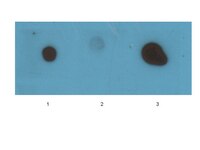Neuroinflammation and related neuropathologies in APPSL mice: further value of this in vivo model of Alzheimer's disease.
Löffler, T; Flunkert, S; Havas, D; Schweinzer, C; Uger, M; Windisch, M; Steyrer, E; Hutter-Paier, B
Journal of neuroinflammation
11
84
2014
Show Abstract
Beyond cognitive decline, Alzheimer's disease (AD) is characterized by numerous neuropathological changes in the brain. Although animal models generally do not fully reflect the broad spectrum of disease-specific alterations, the APPSL mouse model is well known to display early plaque formation and to exhibit spatial learning and memory deficits. However, important neuropathological features, such as neuroinflammation and lipid peroxidation, and their progression over age, have not yet been described in this AD mouse model.Hippocampal and neocortical tissues of APPSL mice at different ages were evaluated. One hemisphere from each mouse was examined for micro- and astrogliosis as well as concomitant plaque load. The other hemisphere was evaluated for lipid peroxidation (quantified by a thiobarbituric acid reactive substances (TBARS) assay), changes in Aβ abundance (Aβ38, Aβ40 and Aβ42 analyses), as well as determination of aggregated Aβ content (Amorfix A4 assay). Finally, correlation analyses were performed to illustrate the time-dependent correlation between neuroinflammation and Aβ load (soluble, insoluble, fibrils), or lipid peroxidation, respectively.As is consistent with previous findings, neuroinflammation starts early and shows strong progression over age in the APPSL mouse model. An analyses of concomitant Aβ load and plaque deposition revealed a similar progression, and high correlations between neuroinflammation markers and soluble or insoluble Aβ or fibrillar amyloid plaque loads were observed. Lipid peroxidation, as measured by TBARS levels, correlates well with neuroinflammation in the neocortex but not the hippocampus. The hippocampal lipid peroxidation correlated strongly with the increase of LOC positive fiber load, whereas neocortical TBARS levels were unrelated to amyloidosis.These data illustrate for the first time the progression of major AD related neuropathological features other than plaque load in the APPSL mouse model. Specifically, we demonstrate that microgliosis and astrocytosis are prominent aspects of this AD mouse model. The strong correlation of neuroinflammation with amyloid burden and lipid peroxidation underlines the importance of these pathological factors for the development of AD. The new finding of a different relation of lipid peroxidation in the hippocampus and neocortical regions show that the model might contribute to the understanding of complex pathological mechanisms and their interplay in AD. | Immunohistochemistry | 24886182
 |
Fibril specific, conformation dependent antibodies recognize a generic epitope common to amyloid fibrils and fibrillar oligomers that is absent in prefibrillar oligomers.
Kayed, Rakez, et al.
Mol Neurodegener, 2: 18 (2007)
2007
Show Abstract
ABSTRACT: BACKGROUND: Amyloid-related degenerative diseases are associated with the accumulation of misfolded proteins as amyloid fibrils in tissue. In Alzheimer disease (AD), amyloid accumulates in several distinct types of insoluble plaque deposits, intracellular Abeta and as soluble oligomers and the relationships between these deposits and their pathological significance remains unclear. Conformation dependent antibodies have been reported that specifically recognize distinct assembly states of amyloids, including prefibrillar oligomers and fibrils. RESULTS: We immunized rabbits with a morphologically homogeneous population of Abeta42 fibrils. The resulting immune serum (OC) specifically recognizes fibrils, but not random coil monomer or prefibrillar oligomers, indicating fibrils display a distinct conformation dependent epitope that is absent in prefibrillar oligomers. The fibril epitope is also displayed by fibrils of other types of amyloids, indicating that the epitope is a generic feature of the polypeptide backbone. The fibril specific antibody also recognizes 100,000 x G soluble fibrillar oligomers ranging in size from dimer to greater than 250 kDa on western blots. The fibrillar oligomers recognized by OC are immunologically distinct from prefibrillar oligomers recognized by A11, even though their sizes overlap broadly, indicating that size is not a reliable indicator of oligomer conformation. The immune response to prefibrillar oligomers and fibrils is not sequence specific and antisera of the same specificity are produced in response to immunization with islet amyloid polypeptide prefibrillar oligomer mimics and fibrils. The fibril specific antibodies stain all types of amyloid deposits in human AD brain. Diffuse amyloid deposits stain intensely with anti-fibril antibody although they are thioflavin S negative, suggesting that they are indeed fibrillar in conformation. OC also stains islet amyloid deposits in transgenic mouse models of type II diabetes, demonstrating its generic specificity for amyloid fibrils. CONCLUSION: Since the fibril specific antibodies are conformation dependent, sequence-independent, and recognize epitopes that are distinct from those present in prefibrillar oligomers, they may have broad utility for detecting and characterizing the accumulation of amyloid fibrils and fibrillar type oligomers in degenerative diseases. | | 17897471
 |









